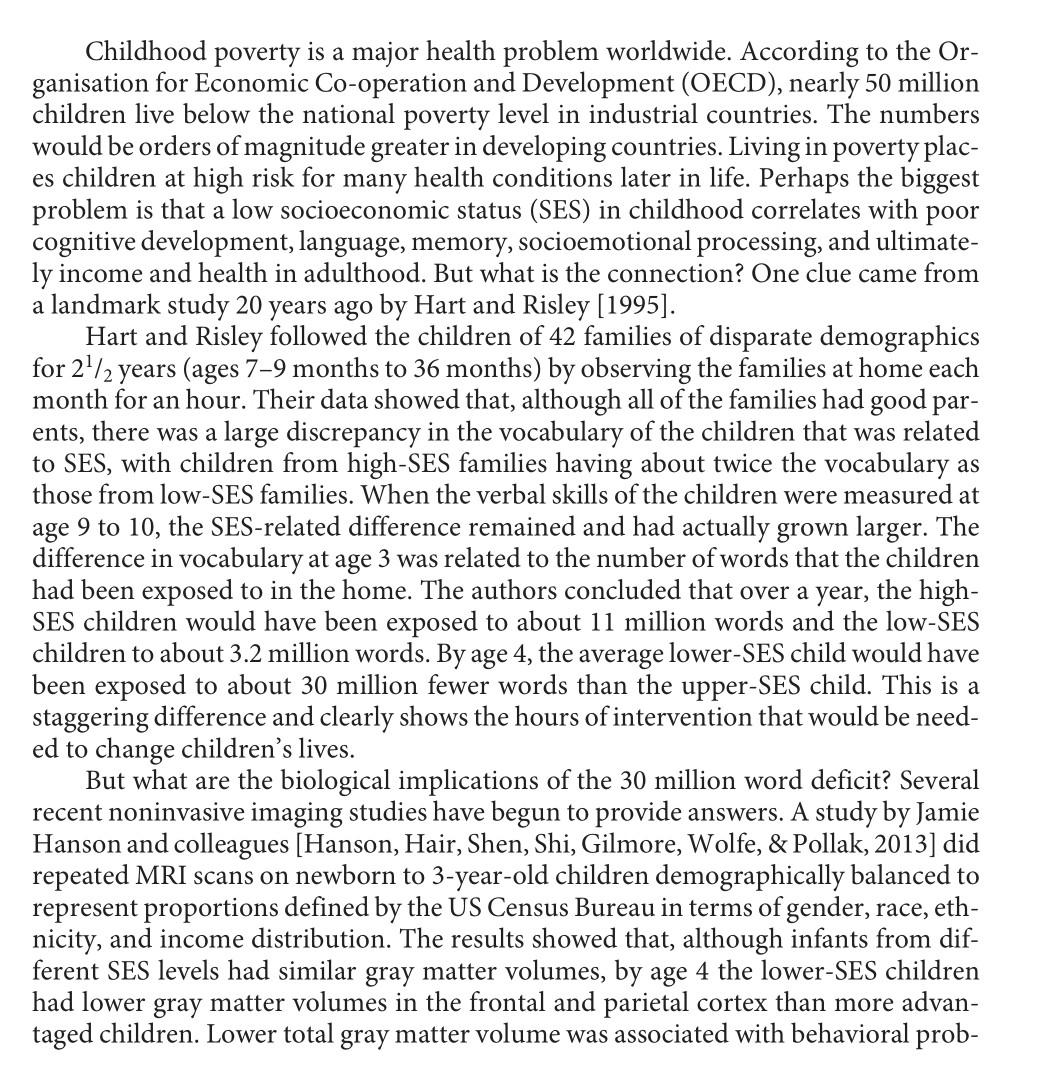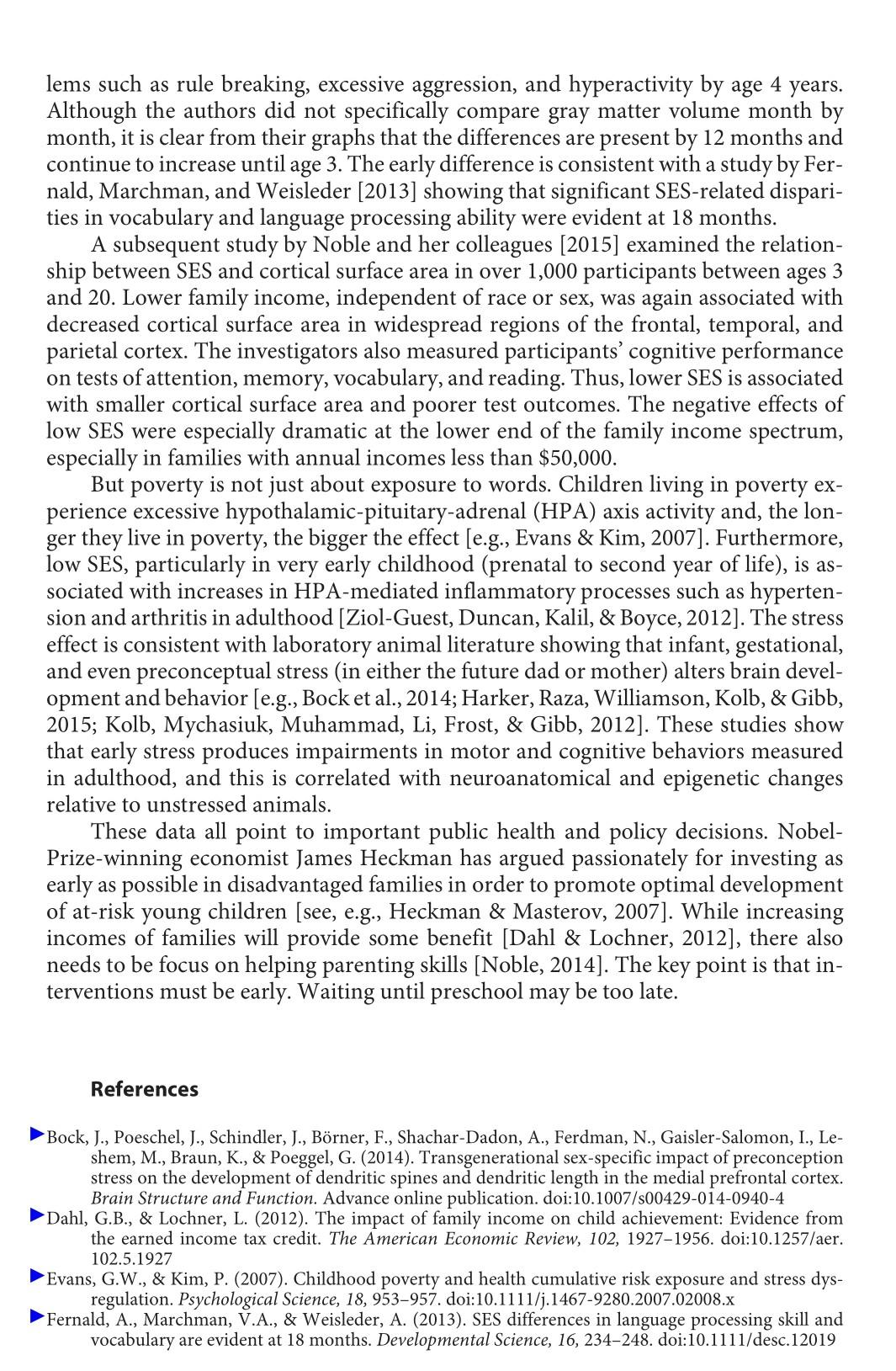Question
1. What is grey matter volume? Explain in your own words. 2. What factors affect grey matter volume? 3. Who advocated for helping disadvantaged families
1. What is grey matter volume? Explain in your own words. 2. What factors affect grey matter volume? 3. Who advocated for helping disadvantaged families and why? 4. What is the HPA and its relationship to poverty? 5. What is the relationship of cortical surface area and poverty? 6. What is stress and what are the effects of prenatal stress? What factors give rise to prenatal stress? 7. What are the biological implications of the 30 million word deficit? 8. Explain the work of Hart and Risiey and what have they concluded? 9. What are the effects of childhood poverty? 10. What is your overall conclusion of this paper?

This is a Rubric, 2 pages required in APA style and double spaced. .


Hello Sir, please read this article for help, otherwise you can take help from Google.
Grades will be given based on the following variables in this check list: 1. Answers in your own words. 2. Specific examples used. 3. Answer is clear. 4. Answer is logical. 5. Answers free of grammatical errors. 6. Answers should be between 200 - 300 words. 7. Answers should be in 12-point font. 8. Assignment submitted on time. Childhood poverty is a major health problem worldwide. According to the Or- ganisation for Economic Co-operation and Development (OECD), nearly 50 million children live below the national poverty level in industrial countries. The numbers would be orders of magnitude greater in developing countries. Living in poverty plac- es children at high risk for many health conditions later in life. Perhaps the biggest problem is that a low socioeconomic status (SES) in childhood correlates with poor cognitive development, language, memory, socioemotional processing, and ultimate- ly income and health in adulthood. But what is the connection? One clue came from a landmark study 20 years ago by Hart and Risley (1995). Hart and Risley followed the children of 42 families of disparate demographics for 27/2 years (ages 79 months to 36 months) by observing the families at home each month for an hour. Their data showed that, although all of the families had good par- ents, there was a large discrepancy in the vocabulary of the children that was related to SES, with children from high-SES families having about twice the vocabulary as those from low-SES families. When the verbal skills of the children were measured at age 9 to 10, the SES-related difference remained and had actually grown larger. The difference in vocabulary at age 3 was related to the number of words that the children had been exposed to in the home. The authors concluded that over a year, the high- SES children would have been exposed to about 11 million words and the low-SES children to about 3.2 million words. By age 4, the average lower-SES child would have been exposed to about 30 million fewer words than the upper-SES child. This is a staggering difference and clearly shows the hours of intervention that would be need- ed to change children's lives. But what are the biological implications of the 30 million word deficit? Several recent noninvasive imaging studies have begun to provide answers. A study by Jamie Hanson and colleagues (Hanson, Hair, Shen, Shi, Gilmore, Wolfe, & Pollak, 2013] did repeated MRI scans on bo to 3-year-old children demographically balanced to represent proportions defined by the US Census Bureau in terms of gender, race, eth- nicity, and income distribution. The results showed that, although infants from dif- ferent SES levels had similar gray matter volumes, by age 4 the lower-SES children had lower gray matter volumes in the frontal and parietal cortex than more advan- taged children. Lower total gray matter volume was associated with behavioral prob- lems such as rule breaking, excessive aggression, and hyperactivity by age 4 years. Although the authors did not specifically compare gray matter volume month by month, it is clear from their graphs that the differences are present by 12 months and continue to increase until age 3. The early difference is consistent with a study by Fer- nald, Marchman, and Weisleder [2013] showing that significant SES-related dispari- ties in vocabulary and language processing ability were evident at 18 months. A subsequent study by Noble and her colleagues (2015) examined the relation- ship between SES and cortical surface area in over 1,000 participants between ages 3 and 20. Lower family income, independent of race or sex, was again associated with decreased cortical surface area in widespread regions of the frontal, temporal, and parietal cortex. The investigators also measured participants' cognitive performance on tests of attention, memory, vocabulary, and reading. Thus, lower SES is associated with smaller cortical surface area and poorer test outcomes. The negative effects of low SES were especially dramatic at the lower end of the family income spectrum, especially in families with annual incomes less than $50,000. But poverty is not just about exposure to words. Children living in poverty ex- perience excessive hypothalamic-pituitary-adrenal (HPA) axis activity and, the lon- ger they live in poverty, the bigger the effect [e.g., Evans & Kim, 2007]. Furthermore, low SES, particularly in very early childhood (prenatal to second year of life), is as- sociated with increases in HPA-mediated inflammatory processes such as hyperten- sion and arthritis in adulthood (Ziol-Guest, Duncan, Kalil, & Boyce, 2012]. The stress effect is consistent with laboratory animal literature showing that infant, gestational, and even preconceptual stress (in either the future dad or mother) alters brain devel- opment and behavior [e.g., Bock et al., 2014; Harker, Raza, Williamson, Kolb, & Gibb, 2015; Kolb, Mychasiuk, Muhammad, Li, Frost, & Gibb, 2012]. These studies show that early stress produces impairments in motor and cognitive behaviors measured in adulthood, and this is correlated with neuroanatomical and epigenetic changes relative to unstressed animals. These data all point to important public health and policy decisions. Nobel- Prize-winning economist James Heckman has argued passionately for investing as early as possible in disadvantaged families in order to promote optimal development of at-risk young children (see, e.g., Heckman & Masterov, 2007). While increasing incomes of families will provide some benefit [Dahl & Lochner, 2012], there also needs to be focus on helping parenting skills [Noble, 2014]. The key point is that in- terventions must be early. Waiting until preschool may be too late. References Bock, J., Poeschel, J., Schindler, J., Brner, F., Shachar-Dadon, A., Ferdman, N., Gaisler-Salomon, I., Le- shem, M., Braun, K., & Poeggel, G. (2014). Transgenerational sex-specific impact of preconception stress on the development of dendritic spines and dendritic length in the medial prefrontal cortex. Brain Structure and Function. Advance online publication. doi:10.1007/s00429-014-0940-4 Dahl, G.B., & Lochner, L. (2012). The impact of family income on child achievement: Evidence from the earned income tax credit. The American Economic Review, 102, 1927-1956. doi:10.1257/aer. 102.5.1927 Evans, G.W., & Kim, P. (2007). Childhood poverty and health cumulative risk exposure and stress dys- regulation. Psychological Science, 18, 953-957. doi:10.1111/j.1467-9280.2007.02008.X Fernald, A., Marchman, V.A., & Weisleder, A. (2013). SES differences in language processing skill and vocabulary are evident at 18 months. Developmental Science, 16, 234-248. doi:10.1111/desc.12019 Grades will be given based on the following variables in this check list: 1. Answers in your own words. 2. Specific examples used. 3. Answer is clear. 4. Answer is logical. 5. Answers free of grammatical errors. 6. Answers should be between 200 - 300 words. 7. Answers should be in 12-point font. 8. Assignment submitted on time. Childhood poverty is a major health problem worldwide. According to the Or- ganisation for Economic Co-operation and Development (OECD), nearly 50 million children live below the national poverty level in industrial countries. The numbers would be orders of magnitude greater in developing countries. Living in poverty plac- es children at high risk for many health conditions later in life. Perhaps the biggest problem is that a low socioeconomic status (SES) in childhood correlates with poor cognitive development, language, memory, socioemotional processing, and ultimate- ly income and health in adulthood. But what is the connection? One clue came from a landmark study 20 years ago by Hart and Risley (1995). Hart and Risley followed the children of 42 families of disparate demographics for 27/2 years (ages 79 months to 36 months) by observing the families at home each month for an hour. Their data showed that, although all of the families had good par- ents, there was a large discrepancy in the vocabulary of the children that was related to SES, with children from high-SES families having about twice the vocabulary as those from low-SES families. When the verbal skills of the children were measured at age 9 to 10, the SES-related difference remained and had actually grown larger. The difference in vocabulary at age 3 was related to the number of words that the children had been exposed to in the home. The authors concluded that over a year, the high- SES children would have been exposed to about 11 million words and the low-SES children to about 3.2 million words. By age 4, the average lower-SES child would have been exposed to about 30 million fewer words than the upper-SES child. This is a staggering difference and clearly shows the hours of intervention that would be need- ed to change children's lives. But what are the biological implications of the 30 million word deficit? Several recent noninvasive imaging studies have begun to provide answers. A study by Jamie Hanson and colleagues (Hanson, Hair, Shen, Shi, Gilmore, Wolfe, & Pollak, 2013] did repeated MRI scans on bo to 3-year-old children demographically balanced to represent proportions defined by the US Census Bureau in terms of gender, race, eth- nicity, and income distribution. The results showed that, although infants from dif- ferent SES levels had similar gray matter volumes, by age 4 the lower-SES children had lower gray matter volumes in the frontal and parietal cortex than more advan- taged children. Lower total gray matter volume was associated with behavioral prob- lems such as rule breaking, excessive aggression, and hyperactivity by age 4 years. Although the authors did not specifically compare gray matter volume month by month, it is clear from their graphs that the differences are present by 12 months and continue to increase until age 3. The early difference is consistent with a study by Fer- nald, Marchman, and Weisleder [2013] showing that significant SES-related dispari- ties in vocabulary and language processing ability were evident at 18 months. A subsequent study by Noble and her colleagues (2015) examined the relation- ship between SES and cortical surface area in over 1,000 participants between ages 3 and 20. Lower family income, independent of race or sex, was again associated with decreased cortical surface area in widespread regions of the frontal, temporal, and parietal cortex. The investigators also measured participants' cognitive performance on tests of attention, memory, vocabulary, and reading. Thus, lower SES is associated with smaller cortical surface area and poorer test outcomes. The negative effects of low SES were especially dramatic at the lower end of the family income spectrum, especially in families with annual incomes less than $50,000. But poverty is not just about exposure to words. Children living in poverty ex- perience excessive hypothalamic-pituitary-adrenal (HPA) axis activity and, the lon- ger they live in poverty, the bigger the effect [e.g., Evans & Kim, 2007]. Furthermore, low SES, particularly in very early childhood (prenatal to second year of life), is as- sociated with increases in HPA-mediated inflammatory processes such as hyperten- sion and arthritis in adulthood (Ziol-Guest, Duncan, Kalil, & Boyce, 2012]. The stress effect is consistent with laboratory animal literature showing that infant, gestational, and even preconceptual stress (in either the future dad or mother) alters brain devel- opment and behavior [e.g., Bock et al., 2014; Harker, Raza, Williamson, Kolb, & Gibb, 2015; Kolb, Mychasiuk, Muhammad, Li, Frost, & Gibb, 2012]. These studies show that early stress produces impairments in motor and cognitive behaviors measured in adulthood, and this is correlated with neuroanatomical and epigenetic changes relative to unstressed animals. These data all point to important public health and policy decisions. Nobel- Prize-winning economist James Heckman has argued passionately for investing as early as possible in disadvantaged families in order to promote optimal development of at-risk young children (see, e.g., Heckman & Masterov, 2007). While increasing incomes of families will provide some benefit [Dahl & Lochner, 2012], there also needs to be focus on helping parenting skills [Noble, 2014]. The key point is that in- terventions must be early. Waiting until preschool may be too late. References Bock, J., Poeschel, J., Schindler, J., Brner, F., Shachar-Dadon, A., Ferdman, N., Gaisler-Salomon, I., Le- shem, M., Braun, K., & Poeggel, G. (2014). Transgenerational sex-specific impact of preconception stress on the development of dendritic spines and dendritic length in the medial prefrontal cortex. Brain Structure and Function. Advance online publication. doi:10.1007/s00429-014-0940-4 Dahl, G.B., & Lochner, L. (2012). The impact of family income on child achievement: Evidence from the earned income tax credit. The American Economic Review, 102, 1927-1956. doi:10.1257/aer. 102.5.1927 Evans, G.W., & Kim, P. (2007). Childhood poverty and health cumulative risk exposure and stress dys- regulation. Psychological Science, 18, 953-957. doi:10.1111/j.1467-9280.2007.02008.X Fernald, A., Marchman, V.A., & Weisleder, A. (2013). SES differences in language processing skill and vocabulary are evident at 18 months. Developmental Science, 16, 234-248. doi:10.1111/desc.12019Step by Step Solution
There are 3 Steps involved in it
Step: 1

Get Instant Access to Expert-Tailored Solutions
See step-by-step solutions with expert insights and AI powered tools for academic success
Step: 2

Step: 3

Ace Your Homework with AI
Get the answers you need in no time with our AI-driven, step-by-step assistance
Get Started


